
FRUITS OF THE HAWAIIAN ISLANDS
BY
GERRIT PARMILE WILDER
GERRIT PARMILE WILDER
(Revised Edition, including Vol. 1, 1906.)
Illustrated by One Hundred and Twenty-One Half-Tone Plates with Descriptions of Same
Illustrated by One Hundred and Twenty-One Half-Tone Plates with Descriptions of Same
Copyright December 1906, December 1911
Gerrit Parmile Wilder
Gerrit Parmile Wilder
Honolulu, T. H.
Published by The Hawaiian Gazette Co., Ltd.
1911
Published by The Hawaiian Gazette Co., Ltd.
1911
INDEX
- Preface5
- Persea gratissima, Avocado, Palta or Alligator Pear, Plate I7
- Persea gratissima, Avocado, Plate II9
- Persea gratissima, Guatamala Avocado, Plate III11
- Punica Granatum, Pomegranate, Plate IV13
- Ficus Carica (common var.), Fig, Plate V15
- Ficus Carica, Fig, Plate VI17
- Ficus Carica (white or lemon var.), Fig, Plate VII19
- Jambosa malaccensis, Mountain Apple or "Ohia Ai," Plate VIII21
- Jambosa sp., Water Apple, Plate IX23
- Jambosa sp. (white var.), Water Apple, Plate X25
- Jambosa sp. (red var.), Water Apple, Plate XI27
- Eugenia Jambos, Rose Apple, Plate XII29
- Eugenia brasiliensis, Brazilian Plum or Spanish Cherry, Plate XIII31
- Eugenia uniflora, French Cherry, Plate XIV33
- Eugenia sp., Plate XV35
- Syzygium Jambolana, Java Plum, Plate XVI37
- Syzygium Jambolana (small variety), Java Plum, Plate XVII39
- Averrhoa Carambola, Plate XVIII41
- Achras Sapota, Sapodilla or Naseberry, Plate XIX43
- Casimiroa edulis, White Sapodilla, Plate XX45
- Prunus Persica, Peach, Plate XXI47
- Chrysophyllum Cainito (purple var.), Star Apple, Plate XXII49
- Chrysophyllum Cainito (white var.), Star Apple, Plate XXIII51
- Chrysophyllum monopyrenum, Plate XXIV53
- Mimusops Elengi, Plate XXV55
- Spondias dulcis, "Wi," Plate XXVI57
- Spondias lutea, Hog Plum, Plate XXVII59
- Mammea Americana, Mammee Apple, Plate XXVIII61
- Tamarindus indica, Tamarind, Plate XXIX63
- Durio zibethinus, Durion, Plate XXX65
- Coffea arabica, Arabian Coffee, Plate XXXI67
- Coffea liberica, Liberian Coffee, Plate XXXII69
- Clausena Wampi, Wampi, Plate XXXIII71
- Physalis peruviana, Cape Gooseberry or "Poha," Plate XXXIV73
- Carica Papaya, Papaya (fruit, female tree), Plate XXXV75
- Carica Papaya, Papaya (fruit, male tree), Plate XXXVI77
- Carica quercifolia, Plate XXXVII79
- Citrus Japonica (var. "Hazara"), Chinese Orange, Plate XXXVIII81
- Citrus Japonica, Kumquat, Plate XXXIX83
- Citrus Nobilis, Mandarin Orange, Plate XL85
- Citrus medica limetta, Lime, Plate XLI87
- Citrus medica limonum, Lemon, Plate XLII89
- Citrus medica (var. limonum), Rough-skin Lemon, Plate XLIII91
- Citrus Aurantium Sinense, Waialua Orange, Plate XLIV93
- Citrus Aurantium, Bahia or Washington Navel Orange, Plate XLV95
- Citrus Decumana, Pomelo or Shaddock (pear-shaped var.), Plate XLVI97
- Citrus Decumana, Pomelo or Shaddock (round var.), Plate XLVII99
- Artocarpus incisa, Breadfruit (Hawaiian var.) or "Ulu," Plate XLVIII101
- Artocarpus incisa, Breadfruit (Samoan var.), Plate XLIX103
- Artocarpus incisa, Breadfruit (Tahitian var.), Plate L105
- Artocarpus incisa, Fertile Breadfruit, Plate LI107
- Artocarpus integrifolia, Jack Fruit, Plate LII109
- Anona muricata, Sour Sop, Plate LIII111
- Anona Cherimolia, Cherimoyer, Plate LIV113
- Anona reticulata, Custard Apple, Plate LV115
- Anona squamosa, Sugar Apple or Sweet Sop, Plate LVI117
- Psidium Guayava pomiferum, Common Guava, Plate LVII119
- Psidium Guayava, Sweet Red Guava, Plate LVIII121
- Psidium Guayava, White Lemon Guava, Plate LIX123
- Psidium Guayava pyriferum, "Waiawi," Plate LX125
- Psidium Cattleyanum, Strawberry Guava, Plate LXI127
- Psidium Cattleyanum (var. lucidum), Plate LXII129
- Psidium molle, Plate LXIII131
- Mangifera indica, Mango, Plate LXIV133
- Mangifera indica, Manini Mango, Plate LXV135
- Mangifera indica, No. 9 Mango, Plate LXVI137
- Musa (var.), Banana or "Maia," Plate LXVII139
- Morinda citrifolia, "Noni," Plate LXVIII141
- Vaccinium reticulatum, "Ohelo," Plate LXIX143
- Solanum pimpinellifolium, Currant Tomato, Plate LXX145
- Solanum Lycopersicum, Grape Tomato, Plate LXX145
- Solanum nodiflorum, "Popolo," Plate LXXI147
- Aleurites moluccana, Candlenut Tree or "Kukui Nut," Plate LXXII149
- Terminalia Catappa, Tropical Almond or "Kamani," Plate LXXIII151
- Calophyllum inophyllum "Kamani," Plate LXXIV153
- Noronhia emarginata, Plate LXXV155
- Castanea sativa, Japanese Chestnut, Plate LXXVI157
- Inocarpus edulis, Tahitian Chestnut, Plate LXXVII159
- Canarium commune, Canary Nut, Plate LXXVIII161
- Canarium commune, Canary Nut (round var.), Plate LXXIX163
- Macadamia ternifolia, Queensland Nut, Plate LXXX165
- Macadamia sp., Plate LXXXI167
- Aegle Marmelos, Bhel or Bael Fruit, Plate LXXXII169
- Diospyros decandra, Brown Persimmon, Plate LXXXIII171
- Lucuma Rivicoa, Plate LXXXIV173
- Eriobotrya Japonica, Loquat, Plate LXXXV175
- Litchi Chinensis, "Lichee," Plate LXXXVI177
- Euphoria Longana, Longan, Plate LXXXVII179
- Morus nigra, Mulberry, Plate LXXXVIII181
- Garcinia mangostana, Mangosteen, Plate LXXXIX183
- Garcinia Xanthochymus, Plate XC185
- Bunchosia sp., Plate XCI187
- Malpighia glabra, Barbados Cherry, Plate XCII189
- Theobroma Cacao, Cocoa or Chocolate Tree, Plate XCIII191
- Hibiscus Sabdariffa, Roselle, Plate XCIV193
- Monstera deliciosa, Plate XCV195
- Anacardium occidentale, Cashew Nut, Plate XCVI197
- Ziziphus Jujuba, "Jujube," Plate XCVII199
- Phyllanthus emblica, Plate XCVIII201
- Phyllanthus distichus, Otaheiti Gooseberry, Plate XCIX203
- Olea Europea, Olive, Plate C205
- Vitis Labrusca, "Isabella Grape," Plate CI207
- Pyrus Sinensis, Sand pear, Plate CII209
- Passiflora quadrangularis, Granadilla Vine, Plate CIII211
- Passiflora edulis, Purple Water Lemon or "Lilikoi," Plate CIV213
- Passiflora laurifolia, Yellow Water Lemon, Plate CV215
- Passiflora alata, Plate CVI217
- Passiflora var. foetida, Plate CVII219
- Cereus triangularis, Night-blooming Cereus, Plate CVIII221
- Kigelia pinnata, Sausage Tree, Plate CIX223
- Phoenix dactylifera, The Date Palm, Plate CX225
- Phoenix dactylifera, Date (red and yellow var.), Plate CXI227
- Acrocomia sp., Plate CXII229
- Cocos nucifera, Cocoanut Palm or "Niu," Plate CXIII231
- Cordia collococca, Clammy Cherry, Plate CXIV233
- Flacourtia cataphracta, Plate CXV235
- Atalantia buxifolia, Plate CXVI237
- Bumelia sp., Plate CXVII239
- Ochrosia elliptica, Plate CXVIII241
- Ananas sativus, Pineapple, Plate CXIX243
- Opuntia Tuna, Prickly Pear or "Panini," Plate CXX245
- Prosopis juliflora, Algaroba or "Kiawe," Plate CXXI247
- Detailed Transcriber's Notes.
PREFACE
My original intention with regard to this work, was to publish it in a series of three volumes; and to that end, the first volume was presented to the public in 1906.Since that time, however, I have deemed it advisable, for various reasons, to incorporate all my data in one volume.
I desire to acknowledge my indebtedness for help in my researches, to various works on Horticulture, and to many of my personal friends who have given me valuable assistance.
I trust that this work will prove of some interest, as I believe that it contains a fairly comprehensive list of both the indigenous and naturalized Fruits of the Hawaiian Islands.
GERRIT PARMILE WILDER.
[Pg 6]
Persea gratissima.
Grown in the garden of Gerrit Wilder.
[Pg 7]
G. P. W. Collection. Plate I
Persea gratissima.
AVOCADO, PALTA OR ALLIGATOR PEAR.
Grown in the garden of Gerrit Wilder.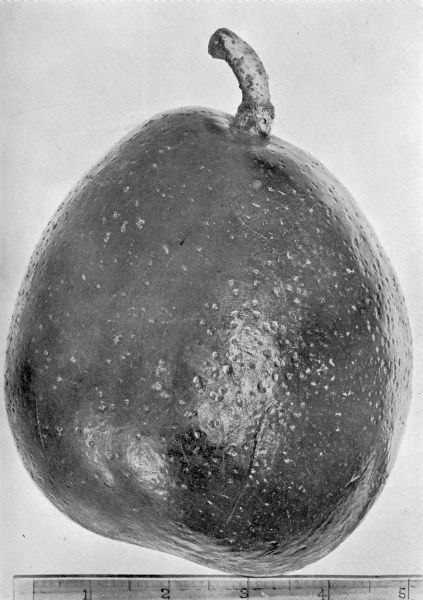
Plate I.—Avocado.
[Pg 8]
Persea gratissima.
This spreading evergreen tree is a native of Tropical America. In the Hawaiian Islands, the first trees of its kind were said to have been planted in Pauoa Valley, Oahu, by Don Marin. It attains a height of from 10 to 40 feet, and is adverse to drought. Its leaves are elliptico-oblong, from 4 to 7 inches in length. The flowers are greenish-yellow and downy. The fruit, which ripens from June until November, is a round or pear-shaped drupe, covered with a thin, rather tough skin, which is either green or purple in color. The flesh is yellow, firm and marrow-like, and has a delicious nutty flavor. The seed-cavity is generally large, containing one round or oblong seed, covered by a thin, brown, parchment-like skin. The quality of the pear is judged, not only by its flavor, but by the presence or absence of strings or fibre in the meat, and also by the quantity of flesh as compared to the size of the seed. Innumerable variations as to size, shape, and quality have been produced from seedlings—some of which may be seen in the accompanying illustration. The Avocado is easily reproduced by budding and grafting, and the best varieties may be obtained in this manner.
[Pg 9]
G. P. W. Collection. Plate II
Persea gratissima.
AVOCADO.
This spreading evergreen tree is a native of Tropical America. In the Hawaiian Islands, the first trees of its kind were said to have been planted in Pauoa Valley, Oahu, by Don Marin. It attains a height of from 10 to 40 feet, and is adverse to drought. Its leaves are elliptico-oblong, from 4 to 7 inches in length. The flowers are greenish-yellow and downy. The fruit, which ripens from June until November, is a round or pear-shaped drupe, covered with a thin, rather tough skin, which is either green or purple in color. The flesh is yellow, firm and marrow-like, and has a delicious nutty flavor. The seed-cavity is generally large, containing one round or oblong seed, covered by a thin, brown, parchment-like skin. The quality of the pear is judged, not only by its flavor, but by the presence or absence of strings or fibre in the meat, and also by the quantity of flesh as compared to the size of the seed. Innumerable variations as to size, shape, and quality have been produced from seedlings—some of which may be seen in the accompanying illustration. The Avocado is easily reproduced by budding and grafting, and the best varieties may be obtained in this manner.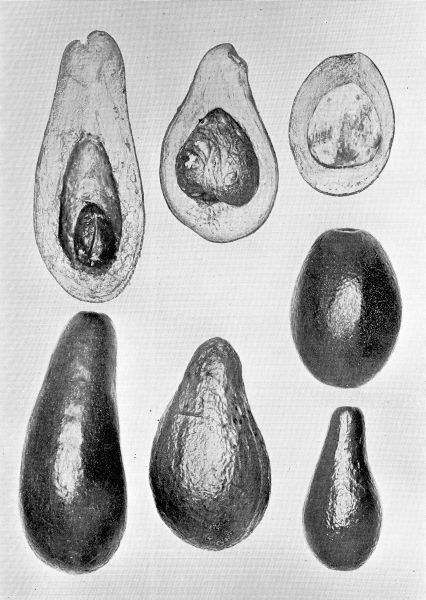
Plate II.—Avocado.
One third natural size.
One third natural size.
[Pg 10]
Persea gratissima.
This variety is a native of Mexico, and although known as the Guatamala Avocado, it is more commonly to be found in the markets of the City of Mexico. Its leaves are purplish-green. The flowers, which appear in May and June, are like those of the preceding variety; and the drupe, which matures in the early part of the year, has a long stem. This fruit is round, from 3 to 5 inches in diameter, has a thick, tough, rough rind, which when ripe is a deep claret color, and the meat, which is a golden-yellow, is tinged with purple next to the rind, and is free from strings or fibres. There are but two trees of this variety bearing fruit in Honolulu. They were propagated from seeds brought here in 1890 by Admiral Beardsley. These two trees are growing in private gardens.
[Pg 11]
G. P. W. Collection. Plate III
Persea gratissima.
GUATAMALA AVOCADO.
This variety is a native of Mexico, and although known as the Guatamala Avocado, it is more commonly to be found in the markets of the City of Mexico. Its leaves are purplish-green. The flowers, which appear in May and June, are like those of the preceding variety; and the drupe, which matures in the early part of the year, has a long stem. This fruit is round, from 3 to 5 inches in diameter, has a thick, tough, rough rind, which when ripe is a deep claret color, and the meat, which is a golden-yellow, is tinged with purple next to the rind, and is free from strings or fibres. There are but two trees of this variety bearing fruit in Honolulu. They were propagated from seeds brought here in 1890 by Admiral Beardsley. These two trees are growing in private gardens.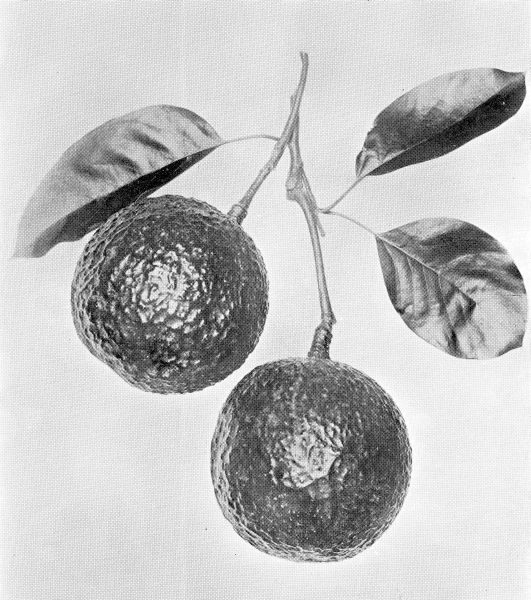
Plate III.—Guatamala Avocado.
One half natural size.
One half natural size.
[Pg 12]
Punica Granatum.
The name was derived from the word punicus, of Carthage, near which city it is said to have been discovered; hence malumpunicum, Apple of Carthage, which was the early name of the Pomegranate. It is a native of Northern Africa, and of Southwestern Asia, and is grown in the Himalayas up to an elevation of 6000 feet. It is a deciduous shrub, which by careful training can be made to grow into a tree from 10 to 15 feet high. Many shoots spring from the base of the tree, and should be cut away, as they draw the sap which should go to the fruit-bearing stems. The branches are slender, twiggy, nearly cylindrical, and somewhat thorny. The bark contains about 32 per cent. tannin, and is used for dying the yellow Morocco leather. The peel of the fruit serves also as a dye. There are several varieties of Pomegranate growing in Hawaii: the double-flowering variety is popular as an ornamental plant. All of the varieties are of easy culture, and are readily propagated by means of cuttings of the ripe wood. The leaves are lanceolate, glabrous, and a glossy-green with red veins. The flowers are axillary, solitary or in small clusters, and in color are a very showy rich orange-red. The fruit is about the size of an ordinary orange, has a persistent calyx, and is made up of many small compartments arranged in two series, one above the other. The crisp, sweet, watery pink pulp enveloping each seed is the edible portion of the Pomegranate.
[Pg 13]
G. P. W. Collection. Plate IV
Punica Granatum.
POMEGRANATE.
The name was derived from the word punicus, of Carthage, near which city it is said to have been discovered; hence malumpunicum, Apple of Carthage, which was the early name of the Pomegranate. It is a native of Northern Africa, and of Southwestern Asia, and is grown in the Himalayas up to an elevation of 6000 feet. It is a deciduous shrub, which by careful training can be made to grow into a tree from 10 to 15 feet high. Many shoots spring from the base of the tree, and should be cut away, as they draw the sap which should go to the fruit-bearing stems. The branches are slender, twiggy, nearly cylindrical, and somewhat thorny. The bark contains about 32 per cent. tannin, and is used for dying the yellow Morocco leather. The peel of the fruit serves also as a dye. There are several varieties of Pomegranate growing in Hawaii: the double-flowering variety is popular as an ornamental plant. All of the varieties are of easy culture, and are readily propagated by means of cuttings of the ripe wood. The leaves are lanceolate, glabrous, and a glossy-green with red veins. The flowers are axillary, solitary or in small clusters, and in color are a very showy rich orange-red. The fruit is about the size of an ordinary orange, has a persistent calyx, and is made up of many small compartments arranged in two series, one above the other. The crisp, sweet, watery pink pulp enveloping each seed is the edible portion of the Pomegranate.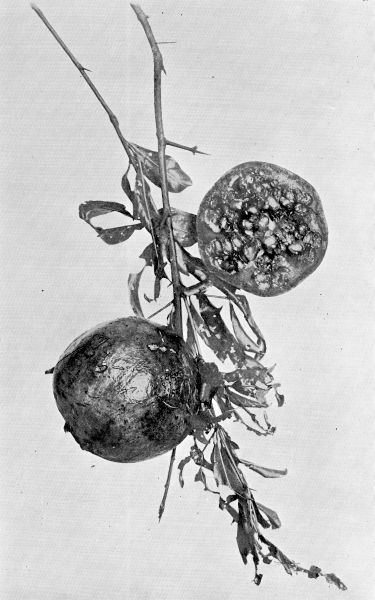
Plate IV.—Pomegranate.
One half natural size.
One half natural size.
[Pg 14]
Ficus Carica (common variety).
The Fig is the most ancient, as well as one of the most valuable of all fruit trees. Its name is nearly the same in all European languages. The tree is supposed to be a native of Caria in Asia Minor. The intelligent cultivators of Anatolia, by whom the Smyrna Figs are produced, adhere to the caprification process, used from time immemorial. In California, efforts have been made to test this process. In the Hawaiian Islands, the Portuguese seem to be the most successful cultivators of the Fig, and several varieties are to be found throughout the group. This common variety grows to a height of from 10 to 20 feet, is hardy, and can easily be propagated from cuttings. Its leaves are alternate, 3 to 5 deeply lobed, and are shed during the fall months, at which season careful pruning will increase the following year's yield. The fruit is single, appearing from the axils of the leaves, on the new wood. It is a hollow, pear-shaped receptacle, containing many minute seeds, scattered throughout a soft, pinkish-white pulp.
[Pg 15]
G. P. W. Collection. Plate V
Ficus Carica (common variety).
FIG.
The Fig is the most ancient, as well as one of the most valuable of all fruit trees. Its name is nearly the same in all European languages. The tree is supposed to be a native of Caria in Asia Minor. The intelligent cultivators of Anatolia, by whom the Smyrna Figs are produced, adhere to the caprification process, used from time immemorial. In California, efforts have been made to test this process. In the Hawaiian Islands, the Portuguese seem to be the most successful cultivators of the Fig, and several varieties are to be found throughout the group. This common variety grows to a height of from 10 to 20 feet, is hardy, and can easily be propagated from cuttings. Its leaves are alternate, 3 to 5 deeply lobed, and are shed during the fall months, at which season careful pruning will increase the following year's yield. The fruit is single, appearing from the axils of the leaves, on the new wood. It is a hollow, pear-shaped receptacle, containing many minute seeds, scattered throughout a soft, pinkish-white pulp.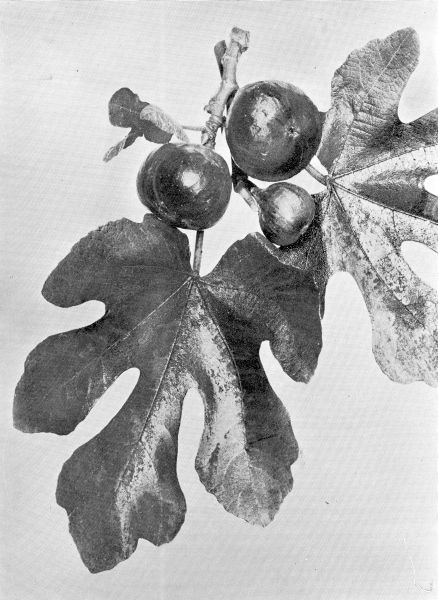
Plate V.—Fig.
One half natural size.
One half natural size.
[Pg 16]
Ficus Carica.
Some years ago, this variety of Fig was to be found growing in large numbers at Makawao, and in the Kula district of Maui. Now, however, there are few, if any, trees remaining, as a destructive blight, together with the lack of proper attention, has caused their extermination. This variety is very prolific. The fruit is small, pear-shaped, and has a particularly sweet and delicious flavor.
[Pg 17]
G. P. W. Collection. Plate VI
Ficus Carica.
FIG.
Some years ago, this variety of Fig was to be found growing in large numbers at Makawao, and in the Kula district of Maui. Now, however, there are few, if any, trees remaining, as a destructive blight, together with the lack of proper attention, has caused their extermination. This variety is very prolific. The fruit is small, pear-shaped, and has a particularly sweet and delicious flavor.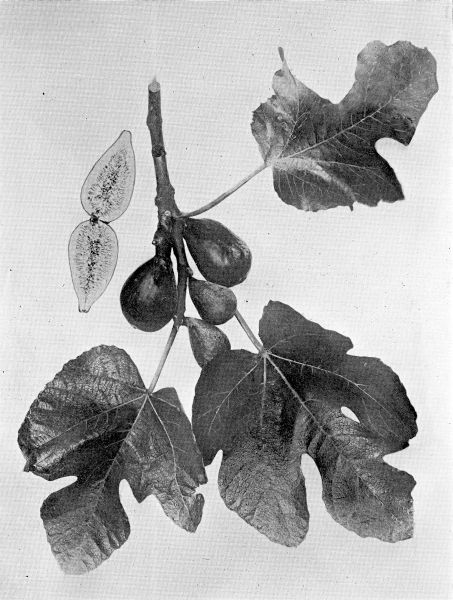
Plate VI.—Fig.
One half natural size.
One half natural size.
[Pg 18]
Ficus Carica (white or lemon variety).
This is a low-growing tree with compact foliage. The leaves are small, and the fruit is round-turbinate, about 1 to 1½ inches in diameter. The skin is very thin, is light-green in color, turning to a greenish-yellow when thoroughly ripe. The pulp is pink, very sweet, and when quite ripe is free from milky juice. This variety is also prolific, is easily dried, and on this account would find a ready sale in our markets.
[Pg 19]
G. P. W. Collection. Plate VII
Ficus Carica (white or lemon variety).
FIG.
This is a low-growing tree with compact foliage. The leaves are small, and the fruit is round-turbinate, about 1 to 1½ inches in diameter. The skin is very thin, is light-green in color, turning to a greenish-yellow when thoroughly ripe. The pulp is pink, very sweet, and when quite ripe is free from milky juice. This variety is also prolific, is easily dried, and on this account would find a ready sale in our markets.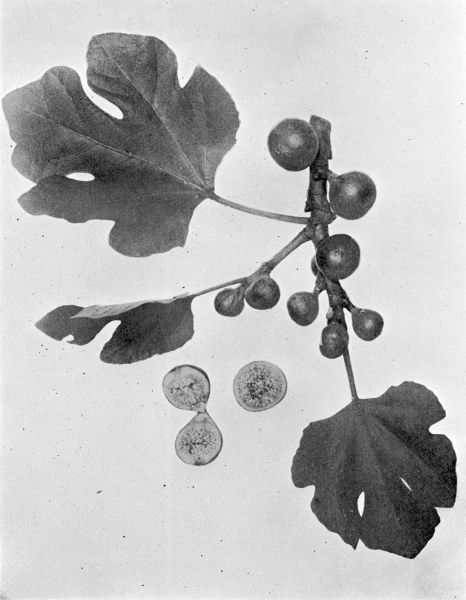
Plate VII.—Fig.
One half natural size.
One half natural size.
[Pg 20]
Jambosa malaccensis.
This tree is found on all the large islands of the Polynesian groups, and in the Malaysian Archipelago. In the Hawaiian Islands it confines itself almost entirely to the moist, shady valleys, and thrives well, up to an elevation of 1800 feet. It is generally gregarious, and on the north side of East Maui it forms a forest belt. It attains a height of from 25 to 50 feet. Its dark, shiny, glabrous leaves are opposite, elliptico-oblong, and from 6 to 7 inches long, and from 2½ to 3 inches broad. The flowers are crimson, fluffy balls, appearing in March and April, on the naked branches and upper trunk of the tree. The fruit, which ripens from July until December, generally contains one seed, is obovate, about 3 inches in diameter. The skin is so thin as to be barely perceptible, and the fruit is very easily bruised. In color, it is a deep, rich crimson, shading into pink and white; the pulp is firm, white, and juicy, with a very agreeable flavor.
[Pg 21]
G. P. W. Collection. Plate VIII
Jambosa malaccensis.
MOUNTAIN APPLE, "OHIA AI."
This tree is found on all the large islands of the Polynesian groups, and in the Malaysian Archipelago. In the Hawaiian Islands it confines itself almost entirely to the moist, shady valleys, and thrives well, up to an elevation of 1800 feet. It is generally gregarious, and on the north side of East Maui it forms a forest belt. It attains a height of from 25 to 50 feet. Its dark, shiny, glabrous leaves are opposite, elliptico-oblong, and from 6 to 7 inches long, and from 2½ to 3 inches broad. The flowers are crimson, fluffy balls, appearing in March and April, on the naked branches and upper trunk of the tree. The fruit, which ripens from July until December, generally contains one seed, is obovate, about 3 inches in diameter. The skin is so thin as to be barely perceptible, and the fruit is very easily bruised. In color, it is a deep, rich crimson, shading into pink and white; the pulp is firm, white, and juicy, with a very agreeable flavor.
Plate VIII.—Mountain Apple.
One third natural size.
One third natural size.
[Pg 22]
Jambosa sp. (Solomon Island variety).
This low-growing tree is very rare in the Hawaiian Islands. It was introduced here, from the Solomon Islands, by Mr. A. Jaeger. The foliage and crimson flowers resemble those of the Jambosa malaccensis, but the drupe is not so highly colored, and is, in shape, much more elongated. Specimens of this sweet, edible fruit have measured 5 inches in length.
[Pg 23]
G. P. W. Collection. Plate IX
Jambosa sp. (Solomon Island variety).
WATER APPLE.
This low-growing tree is very rare in the Hawaiian Islands. It was introduced here, from the Solomon Islands, by Mr. A. Jaeger. The foliage and crimson flowers resemble those of the Jambosa malaccensis, but the drupe is not so highly colored, and is, in shape, much more elongated. Specimens of this sweet, edible fruit have measured 5 inches in length.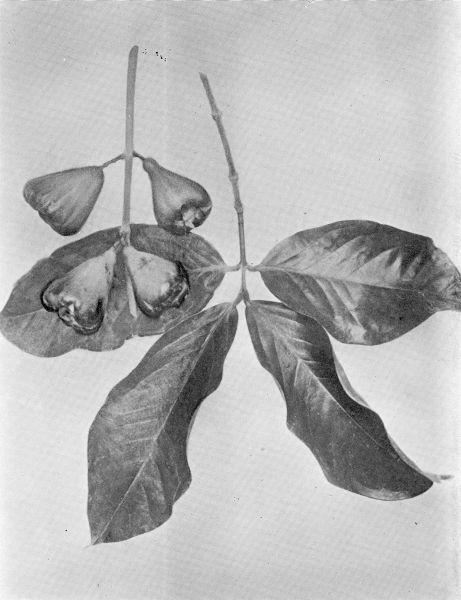
Plate IX.—Water Apple.
One fourth natural size.
One fourth natural size.
[Pg 24]
Jambosa sp. (white variety).
This tree is a native of the Malay Islands. The foliage is symmetrical, and its opposite, shiny leaves are broad, lanceolate, and obtusely-acuminate. The pure white flowers, which bloom from March until June, are about ½-inch in diameter, and are produced in bunches on the naked branches. The fruit, which is also produced in bunches, ripens in October. It is transversely oval in shape, about 1 to 1½ inches in diameter at its largest end. It contains from 1 to 3 seeds. Even when quite ripe, the fruit remains pure white in color, and has a tart, insipid flavor.
[Pg 25]
G. P. W. Collection. Plate X
Jambosa sp. (white variety).
WATER APPLE.
This tree is a native of the Malay Islands. The foliage is symmetrical, and its opposite, shiny leaves are broad, lanceolate, and obtusely-acuminate. The pure white flowers, which bloom from March until June, are about ½-inch in diameter, and are produced in bunches on the naked branches. The fruit, which is also produced in bunches, ripens in October. It is transversely oval in shape, about 1 to 1½ inches in diameter at its largest end. It contains from 1 to 3 seeds. Even when quite ripe, the fruit remains pure white in color, and has a tart, insipid flavor.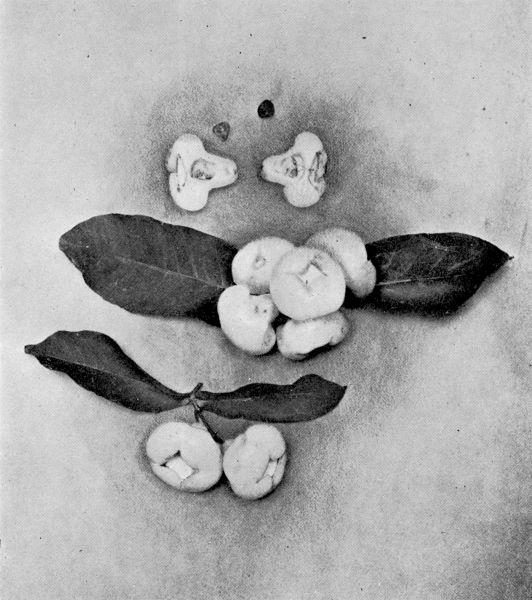
Plate X.—Water Apple.
One half natural size.
One half natural size.
[Pg 26]
Jambosa sp. (red variety).
This low-growing tree with its bright evergreen foliage, is not common in Hawaii. The flowers are small, deep crimson, and appear on the branches either singly or in bunches. The contrast between these brilliant flowers and the fresh green leaves makes a very beautiful sight when the tree is in full bloom. The fruit, which ripens in July, appears in clusters; it is the same shape as that of the preceding variety, but in color it is a bright scarlet. It contains from 1 to 3 seeds, which are somewhat difficult to germinate. The fruit is crisp, watery, and has a sub-acid flavor.
[Pg 27]
G. P. W. Collection. Plate XI
Jambosa sp. (red variety).
WATER APPLE.
This low-growing tree with its bright evergreen foliage, is not common in Hawaii. The flowers are small, deep crimson, and appear on the branches either singly or in bunches. The contrast between these brilliant flowers and the fresh green leaves makes a very beautiful sight when the tree is in full bloom. The fruit, which ripens in July, appears in clusters; it is the same shape as that of the preceding variety, but in color it is a bright scarlet. It contains from 1 to 3 seeds, which are somewhat difficult to germinate. The fruit is crisp, watery, and has a sub-acid flavor.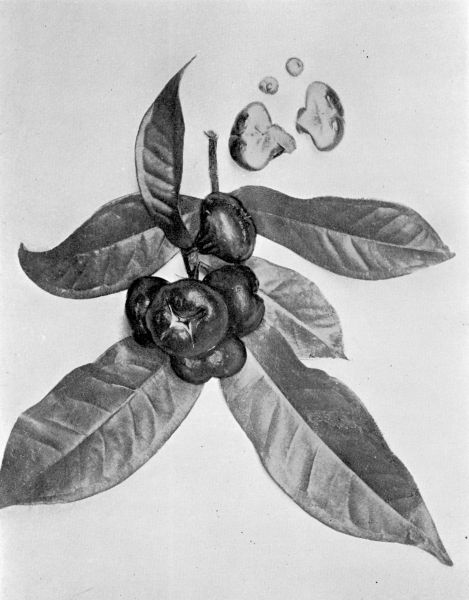
Plate XI.—Water Apple.
One third natural size.
One third natural size.
[Pg 28]
Eugenia Jambos.
This evergreen tree, which is a native of the West Indies, is of medium size, reaching a height of from 20 to 30 feet. It grows well in Hawaii, and is found at an elevation of 2000 feet. It is propagated from seed, as well as from cuttings of the ripe wood. The leaves are lanceolate, acuminate, thick and shiny. The large, fluffy flowers which appear from January until April, are produced freely, and are a beautiful creamy-white. The fruit is a somewhat compressed, globular shell, varying in size from 1 to 2 inches in diameter, and with a large cavity, containing generally one seed. This shell, which is the edible portion of the fruit, is a light creamy-yellow, with a tinge of pale-pink on one side; it requires from 2 to 2½ months to mature. It is firm, crisp, and has a delicious flavor, somewhat resembling an apricot, and with a rose odor. The season for the fruit varies according to the elevation, but generally ends about August or September.
[Pg 29]
G. P. W. Collection. Plate XII
Eugenia Jambos.
ROSE APPLE.
This evergreen tree, which is a native of the West Indies, is of medium size, reaching a height of from 20 to 30 feet. It grows well in Hawaii, and is found at an elevation of 2000 feet. It is propagated from seed, as well as from cuttings of the ripe wood. The leaves are lanceolate, acuminate, thick and shiny. The large, fluffy flowers which appear from January until April, are produced freely, and are a beautiful creamy-white. The fruit is a somewhat compressed, globular shell, varying in size from 1 to 2 inches in diameter, and with a large cavity, containing generally one seed. This shell, which is the edible portion of the fruit, is a light creamy-yellow, with a tinge of pale-pink on one side; it requires from 2 to 2½ months to mature. It is firm, crisp, and has a delicious flavor, somewhat resembling an apricot, and with a rose odor. The season for the fruit varies according to the elevation, but generally ends about August or September.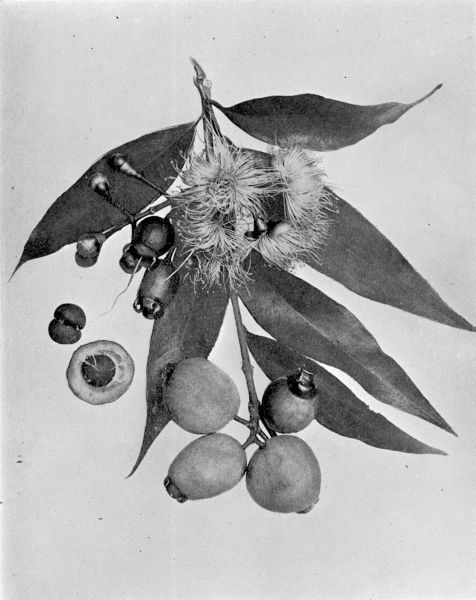
Plate XII.—Rose Apple.
One half natural size.
One half natural size.
[Pg 30]
Eugenia brasiliensis.
This evergreen shrub, or low-growing tree, which in many countries is said to reach a height of but 6 feet, in Hawaii attains a height of 20 feet; and although it thrives in comparatively high altitudes, it bears best below the 200-foot elevation, and requires considerable moisture. The bluntish, dark, shiny leaves, which are scale-like along the branches, are obovate, oblong, and about 3 inches in length. The blossoming season varies according to the location; however, the tree generally has flowers and fruit from July until December. The fruit is the size of a cherry, is deep purple in color, and the persistent calyx is very prominent. The sweet pulp has a very agreeable flavor.
Probably the first plants of this variety were brought here by Don Marin, about a century ago. Some fine trees may be found in Pauoa and Makiki valleys, and also in Nuuanu, in the garden which formerly belonged to Dr. Hillebrand.
[Pg 31]
G. P. W. Collection. Plate XIII
Eugenia brasiliensis.
BRAZILIAN PLUM, OR SPANISH CHERRY.
This evergreen shrub, or low-growing tree, which in many countries is said to reach a height of but 6 feet, in Hawaii attains a height of 20 feet; and although it thrives in comparatively high altitudes, it bears best below the 200-foot elevation, and requires considerable moisture. The bluntish, dark, shiny leaves, which are scale-like along the branches, are obovate, oblong, and about 3 inches in length. The blossoming season varies according to the location; however, the tree generally has flowers and fruit from July until December. The fruit is the size of a cherry, is deep purple in color, and the persistent calyx is very prominent. The sweet pulp has a very agreeable flavor.Probably the first plants of this variety were brought here by Don Marin, about a century ago. Some fine trees may be found in Pauoa and Makiki valleys, and also in Nuuanu, in the garden which formerly belonged to Dr. Hillebrand.

Plate XIII.—Brazilian Plum, or Spanish Cherry.
One half natural size.
One half natural size.
[Pg 32]
Eugenia uniflora.
This shrub is said to be a native of Brazil. In Hawaii, it is a common garden plant, sometimes reaching a height of 10 feet. Its glossy leaves are ovate-lanceolate, and its peduncles short. It has small, single, white fragrant flowers. The mature fruit, which resembles a cherry, is about 1 inch in diameter, and is ribbed longitudinally. It has a delicious, spicy, acid flavor. There is generally one large, round, smooth seed.
[Pg 33]
G. P. W. Collection. Plate XIV
Eugenia uniflora.
FRENCH CHERRY.
This shrub is said to be a native of Brazil. In Hawaii, it is a common garden plant, sometimes reaching a height of 10 feet. Its glossy leaves are ovate-lanceolate, and its peduncles short. It has small, single, white fragrant flowers. The mature fruit, which resembles a cherry, is about 1 inch in diameter, and is ribbed longitudinally. It has a delicious, spicy, acid flavor. There is generally one large, round, smooth seed.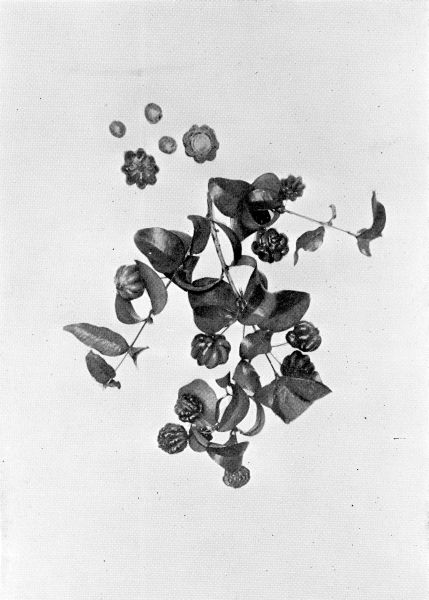
Plate XIV.—French Cherry.
One third natural size.
One third natural size.
[Pg 34]
[Pg 35]
G. P. W. Collection. Plate XV
Eugenia sp.
This is a small Malayan tree which is rare in Hawaii. It has regular, opposite, large, broad leaves; with the stems and branches four-sided. The purplish-white flowers are produced in clusters. The waxy light-green fruits, with a persistent calyx, resemble a small guava. These fruits have a very tough, pithy skin and pulp combined, which is edible, but too dry to be agreeable. The seed is large in proportion to the size of the fruit.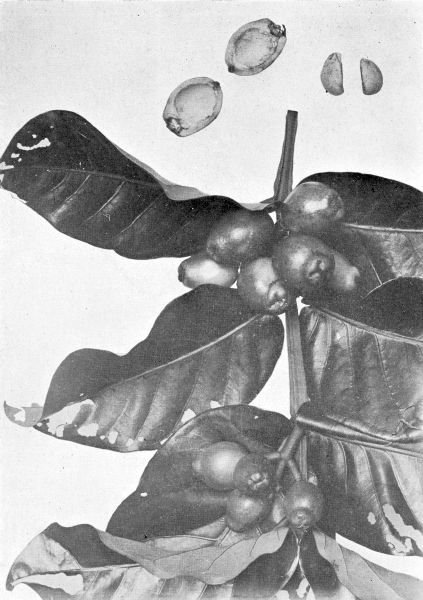
Plate XV.—Eugenia sp.
One half natural size.
One half natural size.
[Pg 36]
Syzygium Jambolana.
This tall, hardy tree is a native of Southern Asia. In Polynesia it grows well, up to an elevation of 5000 feet. It is a very common tree in the Hawaiian Islands. Its leaves, which are from 4 to 6 inches long, and from 2 to 3 inches broad, are opposite, obtuse or shortly-acuminate. The flowers, which bloom in June, July and August, are white and quite fragrant, and are especially attractive to the honey-bee. The oblong fruit grows in large clusters, ripens from September until November, and varies in size from a cherry to a pigeon's egg. It is purplish-black in color, and is edible only when thoroughly ripe. It contains one large, oblong seed.
[Pg 37]
G. P. W. Collection. Plate XVI
Syzygium Jambolana.
JAVA PLUM.
This tall, hardy tree is a native of Southern Asia. In Polynesia it grows well, up to an elevation of 5000 feet. It is a very common tree in the Hawaiian Islands. Its leaves, which are from 4 to 6 inches long, and from 2 to 3 inches broad, are opposite, obtuse or shortly-acuminate. The flowers, which bloom in June, July and August, are white and quite fragrant, and are especially attractive to the honey-bee. The oblong fruit grows in large clusters, ripens from September until November, and varies in size from a cherry to a pigeon's egg. It is purplish-black in color, and is edible only when thoroughly ripe. It contains one large, oblong seed.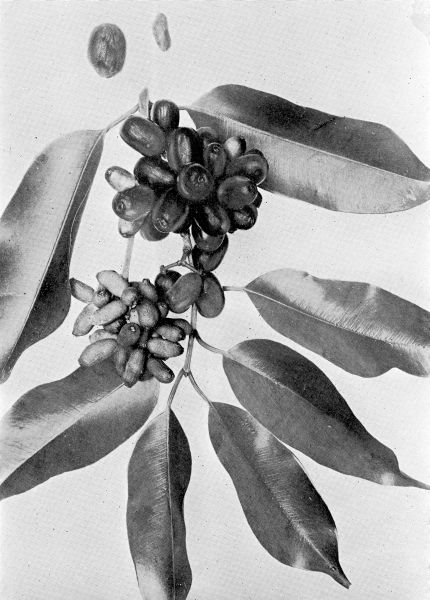
Plate XVI.—Java Plum.
One half natural size.
One half natural size.
[Pg 38]
Syzygium Jambolana (small variety).
This tree, which is also very common in the Hawaiian Islands, is said to have been introduced by Dr. Hillebrand. It bears but one crop a year, will grow in any soil, and withstands dry weather. The foliage is smaller than that of the preceding variety; its leaves are narrower, and a lighter green in color. It blooms at about the same time of year, but its flowers are not as large, and appear in thick bunches. The purplish fruit ripens from September until December.
[Pg 39]
G. P. W. Collection. Plate XVII
Syzygium Jambolana (small variety).
JAVA PLUM.
This tree, which is also very common in the Hawaiian Islands, is said to have been introduced by Dr. Hillebrand. It bears but one crop a year, will grow in any soil, and withstands dry weather. The foliage is smaller than that of the preceding variety; its leaves are narrower, and a lighter green in color. It blooms at about the same time of year, but its flowers are not as large, and appear in thick bunches. The purplish fruit ripens from September until December.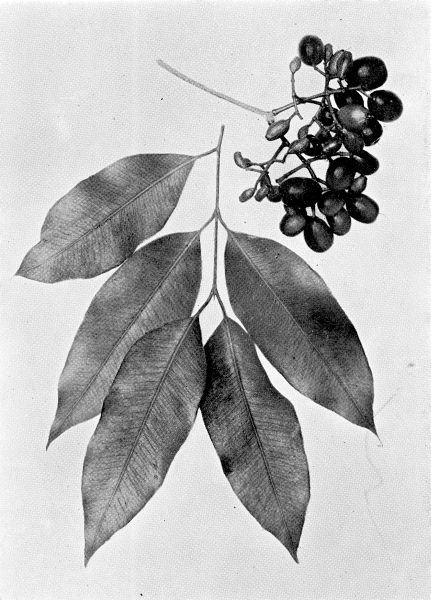
Plate XVII.—Java Plum.
One half natural size.
One half natural size.
[Pg 40]
[Pg 41]
G. P. W. Collection. Plate XVIII
Averrhoa Carambola.
This tree, which is said to have been named after Averrhoes, an Arabian physician, is a native of Insular India, and is much cultivated in India and China. It is evergreen, with dense foliage, and grows to a height of from 15 to 20 feet. It is easily propagated from seeds, and fruits in about three years. In Hawaii it bears one crop annually, the flowers appearing in July and the fruit in November and December. The leaves are alternate, odd-pinnate. The flowers, which are borne in clusters on the naked stems and branches, are minute, fragrant, and in color shading from a pale pink to a deep purplish-red. The fruit, varying in size from a hen's egg to an orange, is ovate, and has five acutely-angled longitudinal ribs. The fragrant, light-yellow skin is very thin, and the pulp is watery; it contains a number of flat, brown seeds. This fruit is of two varieties: the sweet, which may be eaten raw, and the acid which is delicious when preserved. A very appetizing pickle may be made from the half-ripe fruit of the acid variety.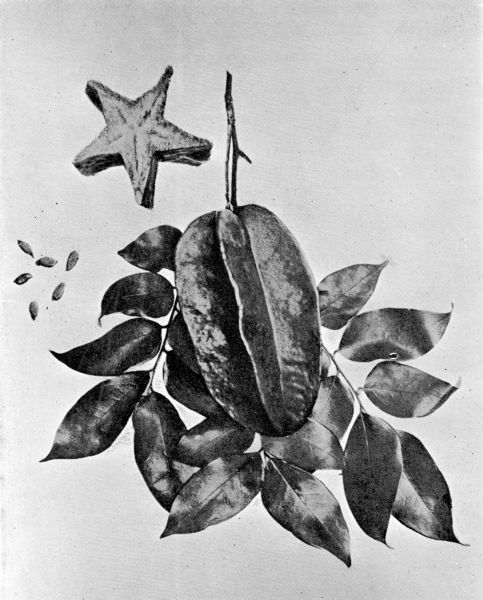
Plate XVIII.—Averrhoa Carambola.
One half natural size.
One half natural size.
[Pg 42]
Achras Sapota.
This tree, which grows on almost all of the Islands of the Hawaiian group, is a fine evergreen, growing to a height of from 10 to 20 feet, and producing a fruit which is much prized in warm countries. The bark possesses tonic properties, and from the juice chewing-gum is made. Its foliage is dense, and the shiny leaves are thick, lance-oblong, entire, and clustered at the ends of the branches. The flowers, which are small, whitish, and perfect, are borne on the rusty pubescent growths of the season. The fruit, of which there are two varieties, the round and the oblong, is about the size of a hen's egg. It has a rough skin, the color of a russet apple, beneath which is a firm, somewhat stringy, sweet pulp, having the flavor of an apricot. This pulp is divided into 10 to 12 compartments, and contains from 4 to 6 large, flat, smooth, black seeds.
[Pg 43]
G. P. W. Collection. Plate XIX
Achras Sapota.
SAPODILLA, OR NASEBERRY.
This tree, which grows on almost all of the Islands of the Hawaiian group, is a fine evergreen, growing to a height of from 10 to 20 feet, and producing a fruit which is much prized in warm countries. The bark possesses tonic properties, and from the juice chewing-gum is made. Its foliage is dense, and the shiny leaves are thick, lance-oblong, entire, and clustered at the ends of the branches. The flowers, which are small, whitish, and perfect, are borne on the rusty pubescent growths of the season. The fruit, of which there are two varieties, the round and the oblong, is about the size of a hen's egg. It has a rough skin, the color of a russet apple, beneath which is a firm, somewhat stringy, sweet pulp, having the flavor of an apricot. This pulp is divided into 10 to 12 compartments, and contains from 4 to 6 large, flat, smooth, black seeds.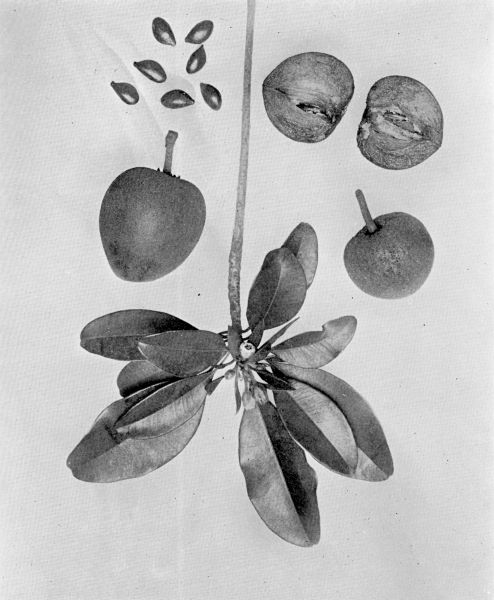
Plate XIX.—Sapodilla, or Naseberry.
One half natural size.
One half natural size.
[Pg 44]
Casimiroa edulis.
This tree, which is a native of Mexico, is said to have been named after Cardinal Casimiro Gomez. The first tree of its kind in Hawaii was planted in 1884, at the Government Nursery, Honolulu. The seed came from Santa Barbara, California, where there grows today, a tree more than eighty years old, and which still bears its fruit. It is a tall evergreen with irregular branches; its digitate leaves are dark and glossy. The trunk is ashen-grey, with warty excrescences. The fruit, which matures in April and May, is large, 1 to 4 inches in diameter; it is depressed-globular and somewhat ribbed, like a tomato; in color it is a light-green, turning to a dull yellow when ripe, and it has a very thin skin. The pulp is yellow, resembling that of an over-ripe, and has a melting, peach-like flavor. It contains from 1 to 3 large, oblong seeds, which are said to be deleterious.
[Pg 45]
G. P. W. Collection. Plate XX
Casimiroa edulis.
WHITE SAPOTA.
This tree, which is a native of Mexico, is said to have been named after Cardinal Casimiro Gomez. The first tree of its kind in Hawaii was planted in 1884, at the Government Nursery, Honolulu. The seed came from Santa Barbara, California, where there grows today, a tree more than eighty years old, and which still bears its fruit. It is a tall evergreen with irregular branches; its digitate leaves are dark and glossy. The trunk is ashen-grey, with warty excrescences. The fruit, which matures in April and May, is large, 1 to 4 inches in diameter; it is depressed-globular and somewhat ribbed, like a tomato; in color it is a light-green, turning to a dull yellow when ripe, and it has a very thin skin. The pulp is yellow, resembling that of an over-ripe, and has a melting, peach-like flavor. It contains from 1 to 3 large, oblong seeds, which are said to be deleterious.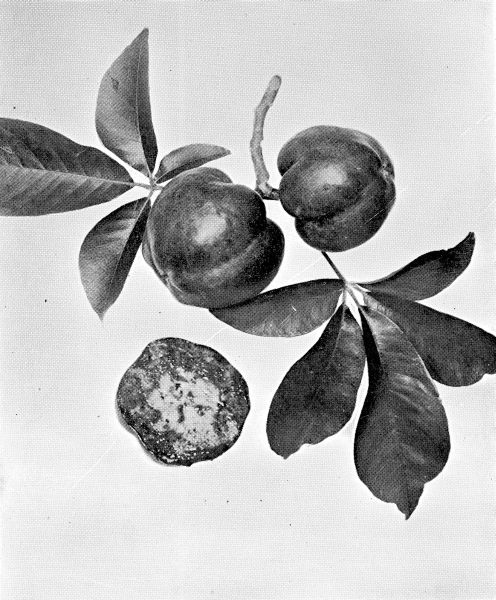
Plate XX.—White Sapota.
One fourth natural size.
One fourth natural size.
[Pg 46]
Prunus Persica.
The Peach-tree is said by some authorities to be indigenous to Persia, while by others it is claimed to be a native of China. It is a hardy tree, and has been known to bear fruit precociously even in the second year after planting. If allowed to do so, the Peach will grow to a height of about 15 feet; but it should be pruned annually, in order to secure a good crop. Its leaves are lanceolate and coarsely serrate. The flowers are solitary, pink in color, and appear before the leaves. The fruit is soft and pubescent at maturity. The stone is deeply pitted and very hard. There are two well-marked varieties, the cling-stone and the free-stone.
Ulupalakua and Makawao, Maui, once had the reputation of growing finely-flavored seedling peaches; however, many of these trees have been injured by cattle, and others have been destroyed by root-fungus and insect pests. In several localities in Hawaii good peaches have been grown from imported varieties.
[Pg 47]
G. P. W. Collection. Plate XXI
Prunus Persica.
PEACH.
The Peach-tree is said by some authorities to be indigenous to Persia, while by others it is claimed to be a native of China. It is a hardy tree, and has been known to bear fruit precociously even in the second year after planting. If allowed to do so, the Peach will grow to a height of about 15 feet; but it should be pruned annually, in order to secure a good crop. Its leaves are lanceolate and coarsely serrate. The flowers are solitary, pink in color, and appear before the leaves. The fruit is soft and pubescent at maturity. The stone is deeply pitted and very hard. There are two well-marked varieties, the cling-stone and the free-stone.Ulupalakua and Makawao, Maui, once had the reputation of growing finely-flavored seedling peaches; however, many of these trees have been injured by cattle, and others have been destroyed by root-fungus and insect pests. In several localities in Hawaii good peaches have been grown from imported varieties.
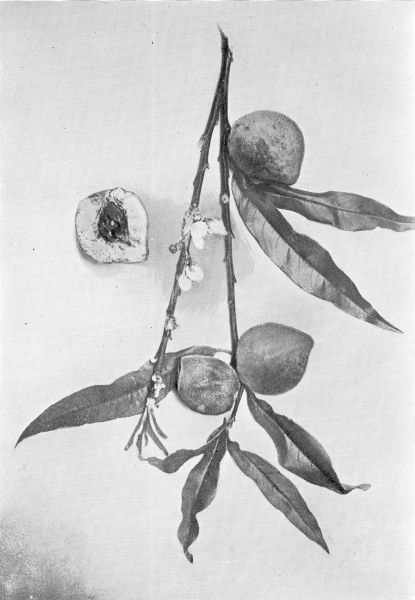
Plate XXI.—Peach.
One half natural size.
One half natural size.
[Pg 48]
Chrysophyllum Cainito (purple variety).
This tree is a native of the West Indies, and although not common in Hawaii, there are good specimens to be found in many gardens. It has large irregular spreading branches, grows to a height of from 10 to 25 feet, and has rather thick foliage. Propagation is ordinarily effected by seeds, which germinate readily, when fresh. It can also be grown from cuttings of the ripe wood. The tree derives its name from the words "chrysos," gold, and "phyllon," a leaf; referring to the golden-russet color of the underside of the beautiful, glossy green leaves. The small flowers, which appear from June until October, are solitary at the nodes or in fascicles. The fruit, which ripens in April, is round, about 3 inches in diameter, has a smooth, tough rind, about 1-16th inch thick, which is a deep purple in color. A cross-section of the fruit shows the edible pulp with its numerous black seeds, and the star-shaped core, from which the fruit derives its common name of Star Apple. Unless the fruit is thoroughly ripe, its milky juice is remarkably astringent.
[Pg 49]
G. P. W. Collection. Plate XXII
Chrysophyllum Cainito (purple variety).
STAR APPLE.
This tree is a native of the West Indies, and although not common in Hawaii, there are good specimens to be found in many gardens. It has large irregular spreading branches, grows to a height of from 10 to 25 feet, and has rather thick foliage. Propagation is ordinarily effected by seeds, which germinate readily, when fresh. It can also be grown from cuttings of the ripe wood. The tree derives its name from the words "chrysos," gold, and "phyllon," a leaf; referring to the golden-russet color of the underside of the beautiful, glossy green leaves. The small flowers, which appear from June until October, are solitary at the nodes or in fascicles. The fruit, which ripens in April, is round, about 3 inches in diameter, has a smooth, tough rind, about 1-16th inch thick, which is a deep purple in color. A cross-section of the fruit shows the edible pulp with its numerous black seeds, and the star-shaped core, from which the fruit derives its common name of Star Apple. Unless the fruit is thoroughly ripe, its milky juice is remarkably astringent.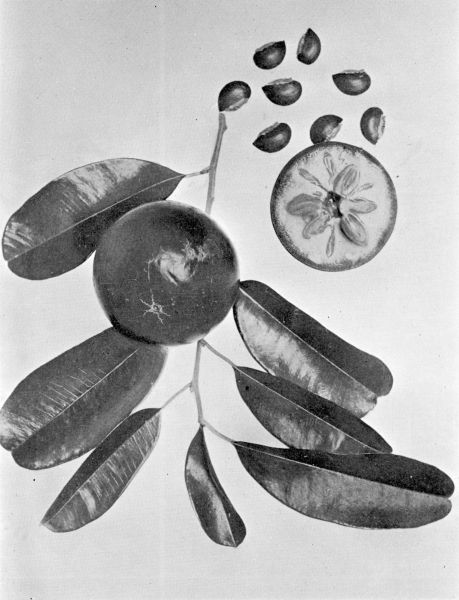
Plate XXII.—Star Apple.
One half natural size.
One half natural size.
[Pg 50]
Chrysophyllum Cainito (white variety).
This tree, which bears its fruit in from four to five years, has about the same characteristics as that of the preceding variety. The fruit is somewhat larger, and is not quite so sweet. In color it is pale green, shaded with purple.
[Pg 51]
G. P. W. Collection. Plate XXIII
Chrysophyllum Cainito (white variety).
STAR APPLE.
This tree, which bears its fruit in from four to five years, has about the same characteristics as that of the preceding variety. The fruit is somewhat larger, and is not quite so sweet. In color it is pale green, shaded with purple.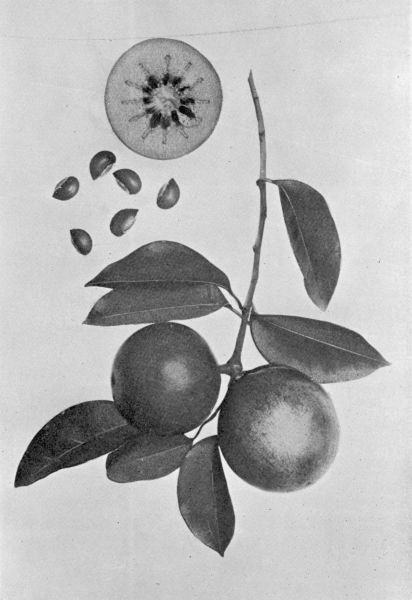
Plate XXIII.—Star Apple.
One half natural size.
One half natural size.
[Pg 52]
[Pg 53]
G. P. W. Collection. Plate XXIV
Chrysophyllum monopyrenum.
This small tree, which is indigenous to the West Indies, is also a native of Southern Florida, and is to be found as an ornamental plant in many localities of tropical America. In Jamaica it is called the "Damson Plum." Its small, single, white flowers are highly perfumed. The fruit, which matures from August until December, is small, ovoid-oblong, and when ripe is purplish-black; when bruised it emits a white, sticky juice. It contains one large seed. Specimens of this tree are to be found growing in the grounds of the Queen's Hospital and at the Government Nursery, Honolulu.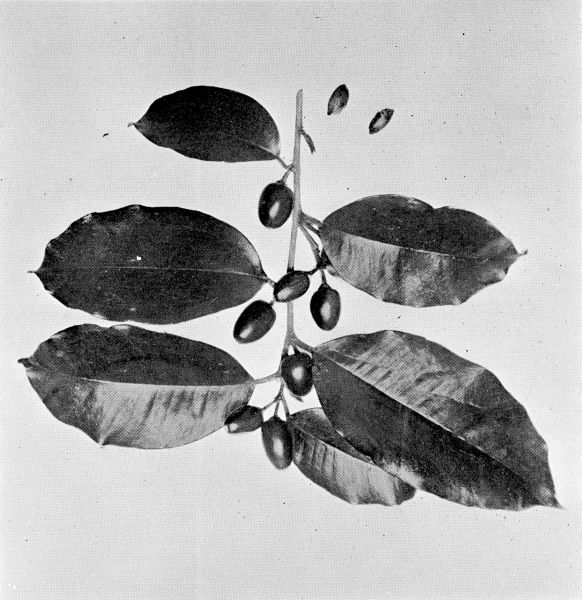
Plate XXIV.—Chrysophyllum monopyrenum.
One half natural size.
One half natural size.
[Pg 54]
[Pg 55]
G. P. W. Collection. Plate XXV
Mimusops Elengi.
This handsome evergreen tree, with its bright, glossy leaves, is very suitable for hedges and for windbreaks. It has alternate, elliptic leaves 3 to 3½ inches long. The small, solitary flowers, have many creamy-white petals, and are very fragrant; from them perfume is obtained by distillation. The yellow fruit is about the shape and size of a small olive, and contains a dry, mealy pulp which is edible, and the large, flat, brown seed yield an oil.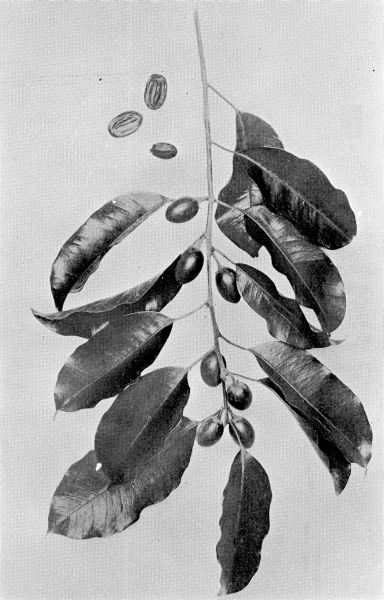
Plate XXV.—Mimusops Elengi.
One half natural size.
One half natural size.
[Pg 56]
Spondias dulcis.
This deciduous tree is said to be a native of the Society Islands, and is common to the tropics of both hemispheres. It is a large, spreading and graceful tree, reaching a height of from 30 to 50 feet. Its pinnate leaves are green and glossy; the leaflets are oval-oblong and opposite. The foliage is shed from December until April. The flowers are paniculate, small, and greenish-white. The fruit, which ripens from November until April, is a fleshy drupe, oval in shape, from 1 to 3 inches in diameter; it has a thin, smooth, golden-yellow skin, which has a rather sour disagreeable odor. The fleshy pulp is light yellow, is mellow when quite ripe, and has a sub-acid delicious flavor, compared by some to the pineapple. Within this pulp is embedded a 1 to 5 loculed, bony endocarp, which contains generally one seed. This endocarp is covered with fibres which penetrate the pulp. The first Wi tree in Hawaii was planted at the residence of Mr. John S. Walker, Nuuanu Valley.
[Pg 57]
G. P. W. Collection. Plate XXVI
Spondias dulcis.
"WI."
This deciduous tree is said to be a native of the Society Islands, and is common to the tropics of both hemispheres. It is a large, spreading and graceful tree, reaching a height of from 30 to 50 feet. Its pinnate leaves are green and glossy; the leaflets are oval-oblong and opposite. The foliage is shed from December until April. The flowers are paniculate, small, and greenish-white. The fruit, which ripens from November until April, is a fleshy drupe, oval in shape, from 1 to 3 inches in diameter; it has a thin, smooth, golden-yellow skin, which has a rather sour disagreeable odor. The fleshy pulp is light yellow, is mellow when quite ripe, and has a sub-acid delicious flavor, compared by some to the pineapple. Within this pulp is embedded a 1 to 5 loculed, bony endocarp, which contains generally one seed. This endocarp is covered with fibres which penetrate the pulp. The first Wi tree in Hawaii was planted at the residence of Mr. John S. Walker, Nuuanu Valley.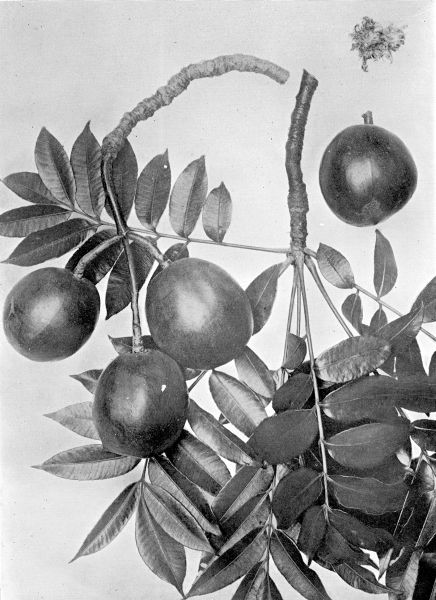
Plate XXVI.—Spondias dulcis.
One third natural size.
One third natural size.
[Pg 58]
Spondias lutea.
This tree is distributed over Tropical America, West Africa and Java, where it is commonly called the Hog Plum, and is used for fattening swine. In Jamaica it grows well, up to an elevation of 4000 feet. It is a large, graceful tree, about 50 feet high, with spreading branches, and it is particularly beautiful when in fruit. The pinnate leaves are a clear green, the leaflets are ovate-lanceolate, and the golden-yellow fruit hangs in clusters. It ripens in September and October. The fruit is ovoid, about 1 inch long; it has a smooth skin, having a disagreeable odor. There is one large seed, which resembles the husk of a ground-nut. This fruit is cooling and aromatic. To my knowledge there are but two trees of this kind in bearing in the Hawaiian Islands, and these are growing in private grounds in Honolulu.
[Pg 59]
G. P. W. Collection. Plate XXVII
Spondias lutea.
HOG PLUM.
This tree is distributed over Tropical America, West Africa and Java, where it is commonly called the Hog Plum, and is used for fattening swine. In Jamaica it grows well, up to an elevation of 4000 feet. It is a large, graceful tree, about 50 feet high, with spreading branches, and it is particularly beautiful when in fruit. The pinnate leaves are a clear green, the leaflets are ovate-lanceolate, and the golden-yellow fruit hangs in clusters. It ripens in September and October. The fruit is ovoid, about 1 inch long; it has a smooth skin, having a disagreeable odor. There is one large seed, which resembles the husk of a ground-nut. This fruit is cooling and aromatic. To my knowledge there are but two trees of this kind in bearing in the Hawaiian Islands, and these are growing in private grounds in Honolulu.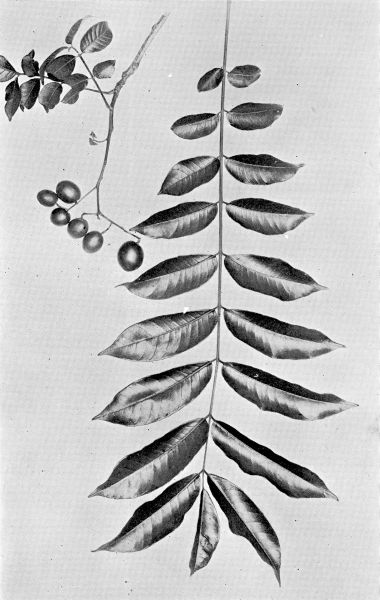
Plate XXVII.—Hog Plum.
One half natural size.
One half natural size.
[Pg 60]
Mammea Americana.
The Mammee Apple, which grows well in Hawaii, is a native of the West Indies, and is a fruit much esteemed in tropical countries. In Jamaica it thrives well, up to an elevation of 3000 feet. The tree attains a height of from 30 to 40 feet, and the wood, which is beautifully grained, is durable and well adapted to building purposes. Its leaves are rigid and leathery. The round seeds, varying in number from 1 to 4, germinate freely, and the young plants are easily raised. The fruit is from 3 to 6 inches in diameter, is brown or russet color, and has a yellow pulp, which is sweet and aromatic. The outer rind, as well as the pulp immediately surrounding the seeds, is very bitter. The fruit may be eaten raw, and is very delicious when preserved.
[Pg 61]
G. P. W. Collection. Plate XXVIII
Mammea Americana.
MAMMEE APPLE.
The Mammee Apple, which grows well in Hawaii, is a native of the West Indies, and is a fruit much esteemed in tropical countries. In Jamaica it thrives well, up to an elevation of 3000 feet. The tree attains a height of from 30 to 40 feet, and the wood, which is beautifully grained, is durable and well adapted to building purposes. Its leaves are rigid and leathery. The round seeds, varying in number from 1 to 4, germinate freely, and the young plants are easily raised. The fruit is from 3 to 6 inches in diameter, is brown or russet color, and has a yellow pulp, which is sweet and aromatic. The outer rind, as well as the pulp immediately surrounding the seeds, is very bitter. The fruit may be eaten raw, and is very delicious when preserved.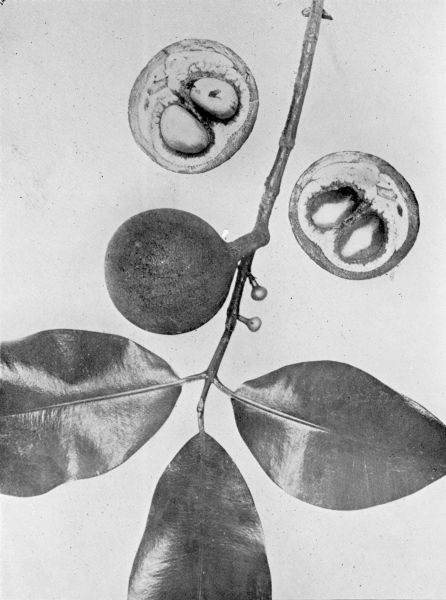
Plate XXVIII.—Mammee Apple.
One fourth natural size.
One fourth natural size.
[Pg 62]
Tamarindus indica.
The name is derived from Tamar, Arabic for Date, and Indus, Indian; thus literally meaning Indian Date. It is a native of the Indies, Egypt and Arabia. The tree is never leafless, and the foliage is graceful, pinnated and acacia like. It bears one crop a year, the season varying somewhat according to the location and elevation. It yields a handsome, hard and close-grained furniture wood, which is yellowish-white, with occasional red streaks in it; the heart-wood is dark brownish-purple. The pods are thick, linear, dark brown in color, and from 3 to 6 inches long. The seeds vary in number. The pulp surrounding the seeds has a pleasant acid flavor, and when made into syrup, forms the basis of a delicious, cooling beverage. This pulp is called the fruit, while the pod is spoken of as the shell. The Tamarind is propagated from both seeds and cuttings, and is undoubtedly one of the noblest of our tropical trees.
[Pg 63]
G. P. W. Collection. Plate XXIX
Tamarindus indica.
TAMARIND.
The name is derived from Tamar, Arabic for Date, and Indus, Indian; thus literally meaning Indian Date. It is a native of the Indies, Egypt and Arabia. The tree is never leafless, and the foliage is graceful, pinnated and acacia like. It bears one crop a year, the season varying somewhat according to the location and elevation. It yields a handsome, hard and close-grained furniture wood, which is yellowish-white, with occasional red streaks in it; the heart-wood is dark brownish-purple. The pods are thick, linear, dark brown in color, and from 3 to 6 inches long. The seeds vary in number. The pulp surrounding the seeds has a pleasant acid flavor, and when made into syrup, forms the basis of a delicious, cooling beverage. This pulp is called the fruit, while the pod is spoken of as the shell. The Tamarind is propagated from both seeds and cuttings, and is undoubtedly one of the noblest of our tropical trees.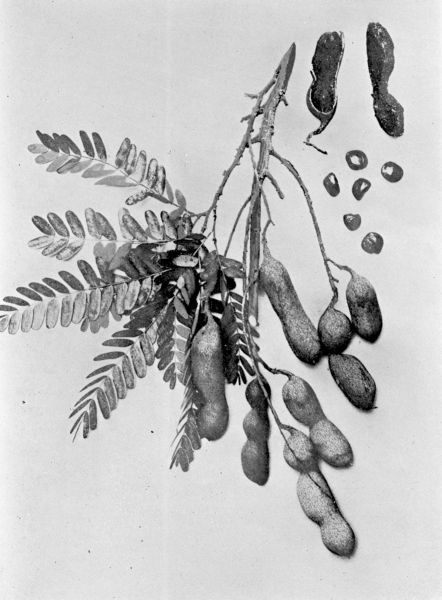
Plate XXIX.—Tamarind.
One half natural size.
One half natural size.
[Pg 64]
Durio zibethinus.
This fine tree attains a height of from 60 to 80 feet; it derives its name from the Malay word "dury," a thorn, in reference to the prickly covering of the fruit. The leaves, which are a light, glossy green on the upper surface, are alternate, entire, elliptical and acute. The yellowish-white flowers are large. The fruit, which is either globular or oval, sometimes measures 10 inches in length. It has a hard rind, covered with thorny warts or spines, and externally looks not unlike a breadfruit. When ripe, it is brownish-yellow, and, when opened at its lower end, shows five longitudinal sections or cells, each containing from 1 to 4 seeds about the size of a pigeon's egg. The edible pulp surrounding the seeds is firm and cream-colored. The Durion is remarkable for its combination of an absolutely delicious flavor and an abominably offensive odor. To my knowledge there is but one tree in bearing in the Hawaiian Islands, and that is growing in private grounds at Lihue, Kauai.
[Pg 65]
G. P. W. Collection. Plate XXX
Durio zibethinus.
DURION.
This fine tree attains a height of from 60 to 80 feet; it derives its name from the Malay word "dury," a thorn, in reference to the prickly covering of the fruit. The leaves, which are a light, glossy green on the upper surface, are alternate, entire, elliptical and acute. The yellowish-white flowers are large. The fruit, which is either globular or oval, sometimes measures 10 inches in length. It has a hard rind, covered with thorny warts or spines, and externally looks not unlike a breadfruit. When ripe, it is brownish-yellow, and, when opened at its lower end, shows five longitudinal sections or cells, each containing from 1 to 4 seeds about the size of a pigeon's egg. The edible pulp surrounding the seeds is firm and cream-colored. The Durion is remarkable for its combination of an absolutely delicious flavor and an abominably offensive odor. To my knowledge there is but one tree in bearing in the Hawaiian Islands, and that is growing in private grounds at Lihue, Kauai.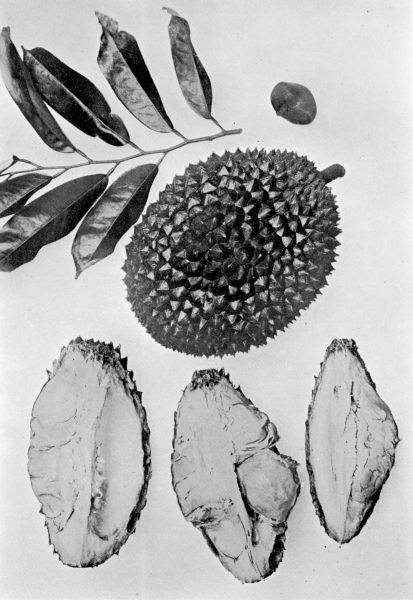
Plate XXX.—Durion.
One third natural size.
One third natural size.
[Pg 66]
Coffea arabica.
The Coffee-tree is said to be a native of Abyssinia. Two species, the Arabian and the Liberian, are now cultivated throughout the tropics. The use of coffee was known in Arabia long before it was introduced to Europeans in the sixteenth century. The Dutch were the first to introduce the plant to Europe. The Arabian Coffee-tree is low-growing, and bears one crop annually; its leaves are elliptico-oblong, acuminate, generally from 3 to 6 inches long, and are thin and shiny. The white flowers appear in clusters, and are very fragrant. The berries are ovoid, fleshy, and bright red. In this berry are found the two seeds, which constitute the coffee of commerce. The Coffee-tree was introduced into Hawaii about 1823, by a Frenchman, who established a small plantation in Manoa Valley, Oahu. The tree is now well naturalized in the woods of Kona, Hawaii, and elsewhere in the Islands, and flourishes up to an elevation of from 1000 to 2000 feet.
[Pg 67]
G. P. W. Collection. Plate XXXI
Coffea arabica.
ARABIAN COFFEE.
The Coffee-tree is said to be a native of Abyssinia. Two species, the Arabian and the Liberian, are now cultivated throughout the tropics. The use of coffee was known in Arabia long before it was introduced to Europeans in the sixteenth century. The Dutch were the first to introduce the plant to Europe. The Arabian Coffee-tree is low-growing, and bears one crop annually; its leaves are elliptico-oblong, acuminate, generally from 3 to 6 inches long, and are thin and shiny. The white flowers appear in clusters, and are very fragrant. The berries are ovoid, fleshy, and bright red. In this berry are found the two seeds, which constitute the coffee of commerce. The Coffee-tree was introduced into Hawaii about 1823, by a Frenchman, who established a small plantation in Manoa Valley, Oahu. The tree is now well naturalized in the woods of Kona, Hawaii, and elsewhere in the Islands, and flourishes up to an elevation of from 1000 to 2000 feet.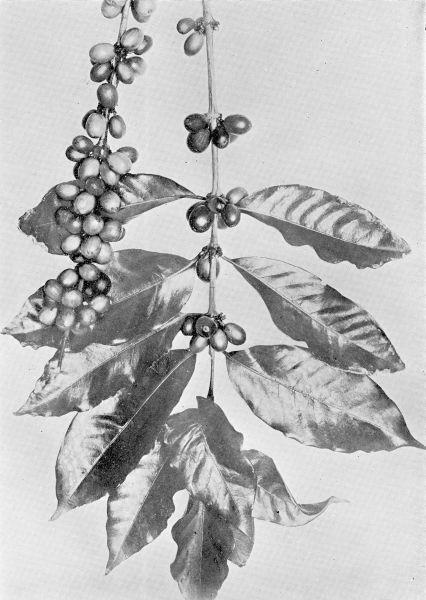
Plate XXXI.—Arabian Coffee.
One half natural size.
One half natural size.
[Pg 68]
Coffea liberica.
This species is a tall grower, is highly ornamental in foliage, and is a rich bearer. Its leaves are from 6 to 12 inches long. The white flowers come in dense clusters, and are more robust and productive than are those of the Arabica. The berries are nearly spherical, and in color are a dull crimson. The pulp is large in proportion to the size of the seeds. Although this variety has not become popular in Hawaii, it is claimed that it will grow at a much lower elevation than will the Arabica, and the flavor is said to be very fine.
[Pg 69]
G. P. W. Collection. Plate XXXII
Coffea liberica.
LIBERIAN COFFEE.
This species is a tall grower, is highly ornamental in foliage, and is a rich bearer. Its leaves are from 6 to 12 inches long. The white flowers come in dense clusters, and are more robust and productive than are those of the Arabica. The berries are nearly spherical, and in color are a dull crimson. The pulp is large in proportion to the size of the seeds. Although this variety has not become popular in Hawaii, it is claimed that it will grow at a much lower elevation than will the Arabica, and the flavor is said to be very fine.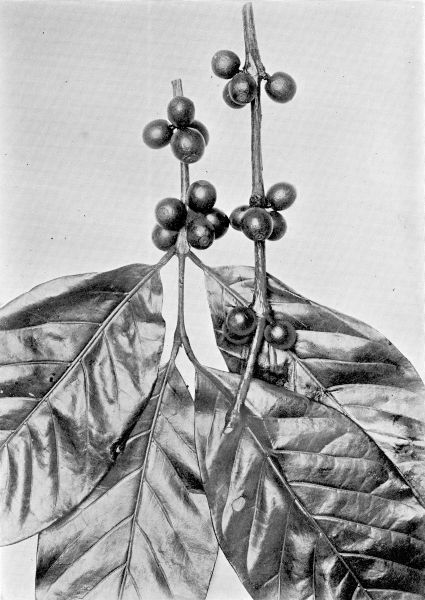
Plate XXXII.—Liberian Coffee.
One half natural size.
One half natural size.
[Pg 70]
Clausena Wampi.
This odorous tree is a native of China. It is a symmetrical evergreen with dense foliage. The light, mossy-green leaves are imparipinnate, the leaflets ovate-repand, and they are rough on the under surface. The flowers, which are borne in clusters, on the new wood, are small, yellow, and very fragrant. The fruit ripens from June until October; it is about the size of a gooseberry; the skin is yellowish-brown, shaded with green. The pulp is sub-acid with a balsamic fragrance. It contains one large seed about the size of a kernel of corn. There are two varieties, the sweet and the sour; both may be eaten raw, and are very highly prized by the Chinese. I know of but two trees of this kind in the Hawaiian Islands; they are of the sour variety, and are growing in private gardens in Honolulu.
[Pg 71]
G. P. W. Collection. Plate XXXIII
Clausena Wampi.
WAMPI.
This odorous tree is a native of China. It is a symmetrical evergreen with dense foliage. The light, mossy-green leaves are imparipinnate, the leaflets ovate-repand, and they are rough on the under surface. The flowers, which are borne in clusters, on the new wood, are small, yellow, and very fragrant. The fruit ripens from June until October; it is about the size of a gooseberry; the skin is yellowish-brown, shaded with green. The pulp is sub-acid with a balsamic fragrance. It contains one large seed about the size of a kernel of corn. There are two varieties, the sweet and the sour; both may be eaten raw, and are very highly prized by the Chinese. I know of but two trees of this kind in the Hawaiian Islands; they are of the sour variety, and are growing in private gardens in Honolulu.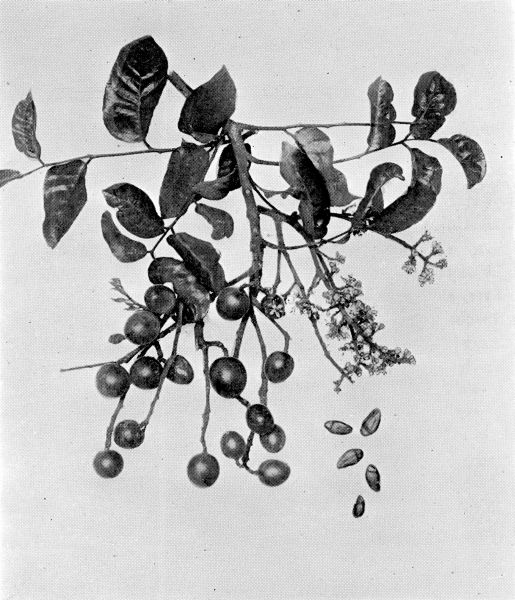
Plate XXXIII.—Wampi.
One half natural size.
One half natural size.
[Pg 72]
Physalis peruviana.
This shrub, or bush, is a native of Brazil, but is naturalized in many warm countries. It stands partially erect, reaching a height of from 1½ to 3 feet. Its pointed leaves, heart-shaped at the base, are very fuzzy. The open, bell-shaped flowers are yellow in color. The fruit, which is about the size of a cherry, is enclosed in a thin, yellow, paper-like husk, which is quite hairy. When ripe, the fruit is yellow, and has a delicious sub-acid pulp, filled with minute seeds. The Poha may be eaten raw, but is much more acceptable when made into jam or jelly. The dried fruit is said to be a substitute for yeast. In Hawaii, the Poha thrives best in the cool elevations.
[Pg 73]
G. P. W. Collection. Plate XXXIV
Physalis peruviana.
CAPE GOOSEBERRY—"POHA."
This shrub, or bush, is a native of Brazil, but is naturalized in many warm countries. It stands partially erect, reaching a height of from 1½ to 3 feet. Its pointed leaves, heart-shaped at the base, are very fuzzy. The open, bell-shaped flowers are yellow in color. The fruit, which is about the size of a cherry, is enclosed in a thin, yellow, paper-like husk, which is quite hairy. When ripe, the fruit is yellow, and has a delicious sub-acid pulp, filled with minute seeds. The Poha may be eaten raw, but is much more acceptable when made into jam or jelly. The dried fruit is said to be a substitute for yeast. In Hawaii, the Poha thrives best in the cool elevations.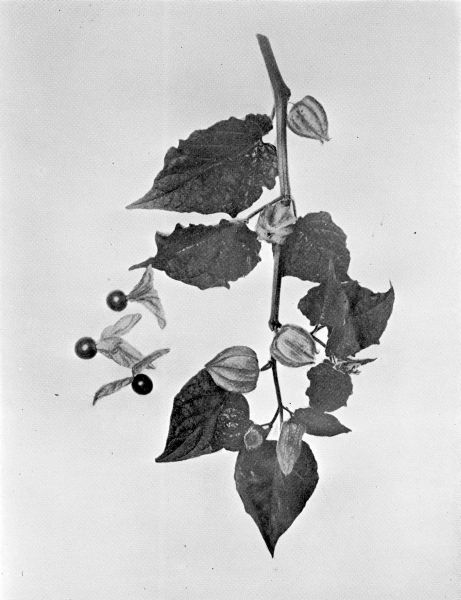
Plate XXXIV.—Cape Gooseberry.
One third natural size.
One third natural size.
[Pg 74]
Carica Papaya.
The Papaya is a native of South America; it is found in Florida, and in many parts of tropical America; it was early introduced into Hawaii, grows and bears well in almost any locality. It is a small tree, with a hollow, branchless trunk; it is short-lived, and is suitable only to regions free from frost, and requires perfect drainage. There are two forms, the tall and the dwarf, but there are numerous variations as to shape and quality of the fruit. The soft green leaves, often measuring two feet across, are variously palmated, and have simple, long, hollow stems. The Papaya is usually dioceous; the fruit-bearing tree is called the female; it is claimed that trees of both sexes should be planted near each other, in order to ensure a good yield. The female flowers, which appear from the axils of the leaves, are yellowish-white, single, or two or three together.
The fruit of the Papaya ripens successively. It is either round or oblong, and sometimes weighs eight pounds. The skin is thin, and is bright yellow when ripe. The firm, yellow pulp has a delicious flavor, and the milky juice contains a digestive principle similar to pepsin. The seed cavity is large, and is filled with many small seeds which are enveloped in a loose, mucous coat, with a brittle, pitted testa. When fresh these seeds germinate readily.
[Pg 75]
G. P. W. Collection. Plate XXXV
Carica Papaya.
PAPAYA (fruit, female tree).
The Papaya is a native of South America; it is found in Florida, and in many parts of tropical America; it was early introduced into Hawaii, grows and bears well in almost any locality. It is a small tree, with a hollow, branchless trunk; it is short-lived, and is suitable only to regions free from frost, and requires perfect drainage. There are two forms, the tall and the dwarf, but there are numerous variations as to shape and quality of the fruit. The soft green leaves, often measuring two feet across, are variously palmated, and have simple, long, hollow stems. The Papaya is usually dioceous; the fruit-bearing tree is called the female; it is claimed that trees of both sexes should be planted near each other, in order to ensure a good yield. The female flowers, which appear from the axils of the leaves, are yellowish-white, single, or two or three together.The fruit of the Papaya ripens successively. It is either round or oblong, and sometimes weighs eight pounds. The skin is thin, and is bright yellow when ripe. The firm, yellow pulp has a delicious flavor, and the milky juice contains a digestive principle similar to pepsin. The seed cavity is large, and is filled with many small seeds which are enveloped in a loose, mucous coat, with a brittle, pitted testa. When fresh these seeds germinate readily.
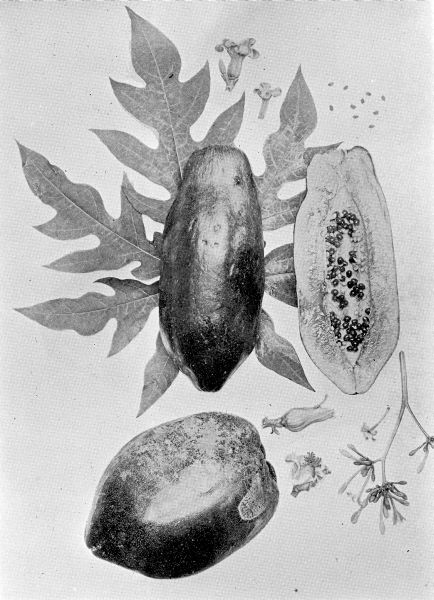
Plate XXXV.—Papaya (fruit, female tree).
One fourth natural size.
One fourth natural size.
[Pg 76]
Carica Papaya.
The size, shape, foliage and general appearance of this tree is the same as that of the preceding variety. Its flowers appear on long stems, are funnel-shape, and have five lobes. The male tree sometimes produces fruit, and it is of large size and fine quality. A good example may be seen in the accompanying illustration.
I know of no method whereby one can, by any selection of seeds, produce with any degree of certainty, plants of either male or female variety.
[Pg 77]
G. P. W. Collection. Plate XXXVI
Carica Papaya.
PAPAYA (fruit, male tree).
The size, shape, foliage and general appearance of this tree is the same as that of the preceding variety. Its flowers appear on long stems, are funnel-shape, and have five lobes. The male tree sometimes produces fruit, and it is of large size and fine quality. A good example may be seen in the accompanying illustration.I know of no method whereby one can, by any selection of seeds, produce with any degree of certainty, plants of either male or female variety.
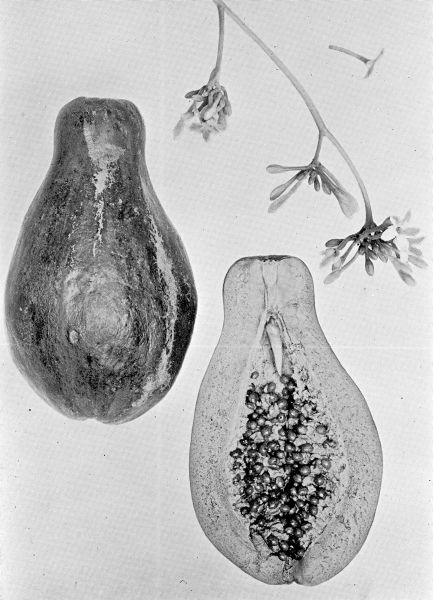
Plate XXXVI.—Papaya (fruit, male tree).
One third natural size.
One third natural size.
[Pg 78]
[Pg 79]
G. P. W. Collection. Plate XXXVII
Carica quercifolia.
This species of dwarf Papaya is of recent introduction to Hawaii. It has a soft, hollow trunk, and low, spreading branches. The leaves are deeply lobed, of a light green color on the upper side, and whitish-green underneath. Flowers dioecious, yellowish-green, having five petals. Fruit the size of a large olive, green, and ribbed with five white stripes, changing to yellow when ripe. The yellow pulp, containing numerous seeds, has a strong pesin flavor that is quite agreeable.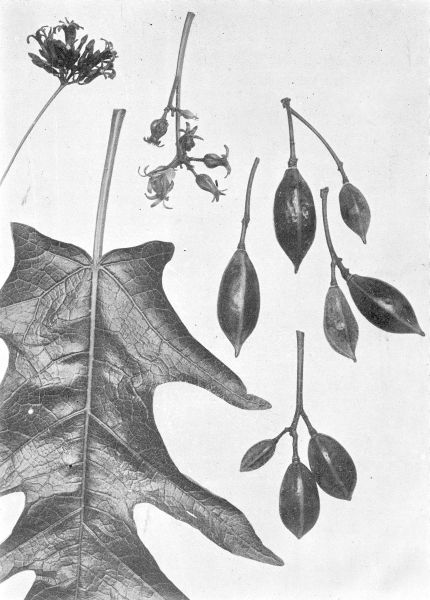
Plate XXXVII.—Carica quercifolia.
One third natural size.
One third natural size.
[Pg 80]
Citrus Japonica.
This familiar and highly ornamental tree, commonly known as the Chinese orange, was very early introduced to these Islands. It is well named Hazara (meaning thousand of fruit), as it is one of the most prolific of the citrus family, and both green and ripe fruit in great quantities may be found on the same tree at almost any season of the year. The tree is of medium size, and the small, shiny leaves have short petioles. It is generally thornless. The flowers are white and fragrant. The round fruit is a deep yellow, and its smooth skin is very loosely attached. The pulp is also a deep yellow and contains many seeds, and the sour juice is very plentiful. The tree is hardy and free from disease and scale. Propagation is by seed.
[Pg 81]
G. P. W. Collection. Plate XXXVIII
Citrus Japonica.
Var. "Hazara."
CHINESE ORANGE.
This familiar and highly ornamental tree, commonly known as the Chinese orange, was very early introduced to these Islands. It is well named Hazara (meaning thousand of fruit), as it is one of the most prolific of the citrus family, and both green and ripe fruit in great quantities may be found on the same tree at almost any season of the year. The tree is of medium size, and the small, shiny leaves have short petioles. It is generally thornless. The flowers are white and fragrant. The round fruit is a deep yellow, and its smooth skin is very loosely attached. The pulp is also a deep yellow and contains many seeds, and the sour juice is very plentiful. The tree is hardy and free from disease and scale. Propagation is by seed.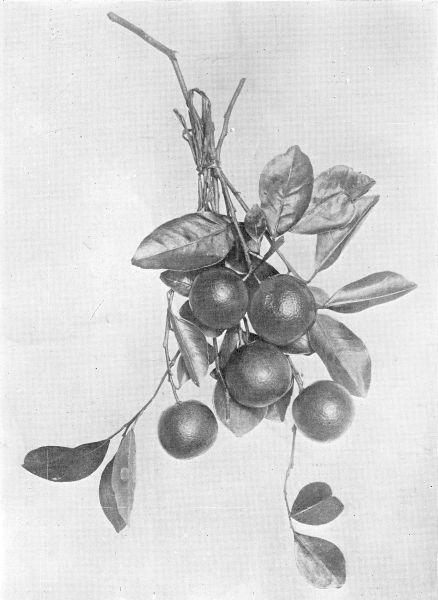
Plate XXXVIII.—Chinese Orange.
One half natural size.
One half natural size.
[Pg 82]
Citrus Japonica.
The Kumquat is a native of Cochin-China, and is also cultivated in Japan, Florida, and California. It is a low-growing bush or shrub, having smooth, angular branches, and in both the round and oval varieties the dark foliage is dense and beautiful. It is a very prolific bearer. Its leaves are small, lanceolate, slightly serrate, pointed or blunt and wedge-shaped at the base. The small, white flowers come solitary or in clusters, the fruit varies in size from a large gooseberry to that of a pigeon's egg, and is either ovate, oblong, or spherical. It is 5 to 6 celled, has very little pulp, and contains many seeds. The pulp is somewhat sour, especially in the round varieties; and the smooth, thick, yellow rind is aromatic and sweet; the Kumquat is generally preserved whole, and those prepared by the Chinese are very delicious.
This ornamental citrus tree is not often seen in our gardens, for it is subject to scale, and to the mealy bug, which destroy the flowers and stunt the fruit. The Kumquat comes true to seed, and may also be propagated by grafting and budding.
[Pg 83]
G. P. W. Collection. Plate XXXIX
Citrus Japonica.
KUMQUAT.
The Kumquat is a native of Cochin-China, and is also cultivated in Japan, Florida, and California. It is a low-growing bush or shrub, having smooth, angular branches, and in both the round and oval varieties the dark foliage is dense and beautiful. It is a very prolific bearer. Its leaves are small, lanceolate, slightly serrate, pointed or blunt and wedge-shaped at the base. The small, white flowers come solitary or in clusters, the fruit varies in size from a large gooseberry to that of a pigeon's egg, and is either ovate, oblong, or spherical. It is 5 to 6 celled, has very little pulp, and contains many seeds. The pulp is somewhat sour, especially in the round varieties; and the smooth, thick, yellow rind is aromatic and sweet; the Kumquat is generally preserved whole, and those prepared by the Chinese are very delicious.This ornamental citrus tree is not often seen in our gardens, for it is subject to scale, and to the mealy bug, which destroy the flowers and stunt the fruit. The Kumquat comes true to seed, and may also be propagated by grafting and budding.
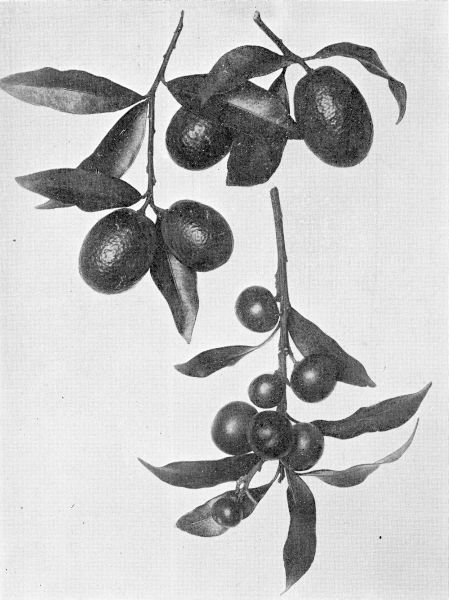
Plate XXXIX.—Kumquat.
Two thirds natural size.
Two thirds natural size.
[Pg 84]
Citrus Nobilis.
This small tree or thornless shrub with its dense foliage is a native of Cochin-China, and fine specimens of this tree, with its golden fruit in season, can be found in many gardens about Honolulu, especially those of the Chinese. Its leaves are lanceolate, its petioles short. Flowers are white and fragrant. The fruit is compressed-spherical, apex depressed, a ridge about the stem. The thin peel is greenish-yellow, baggy, and separates readily from the sections. Pulp generally dry, sweet, juice scant, fruit containing many seeds. The characteristic odor of the leaves, twigs and fruit of all varieties of the Mandarin orange is easily recognizable.
[Pg 85]
G. P. W. Collection. Plate XL
Citrus Nobilis.
MANDARIN ORANGE.
This small tree or thornless shrub with its dense foliage is a native of Cochin-China, and fine specimens of this tree, with its golden fruit in season, can be found in many gardens about Honolulu, especially those of the Chinese. Its leaves are lanceolate, its petioles short. Flowers are white and fragrant. The fruit is compressed-spherical, apex depressed, a ridge about the stem. The thin peel is greenish-yellow, baggy, and separates readily from the sections. Pulp generally dry, sweet, juice scant, fruit containing many seeds. The characteristic odor of the leaves, twigs and fruit of all varieties of the Mandarin orange is easily recognizable.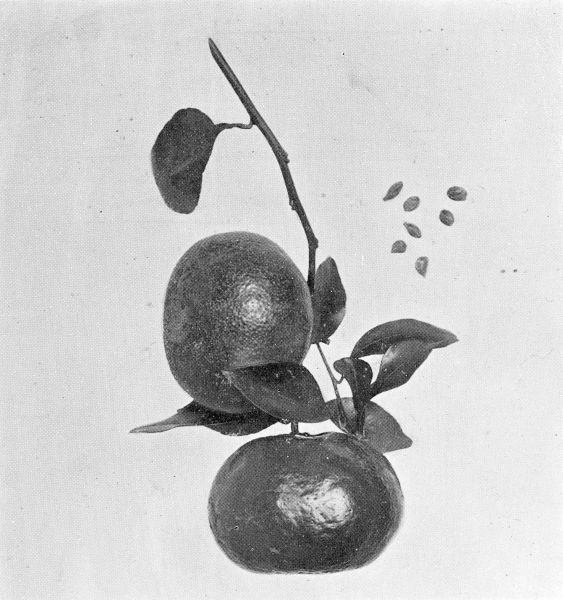
Plate XL.—Mandarin Orange.
Two thirds natural size.
Two thirds natural size.
[Pg 86]
Citrus medica limetta.
This small tree or bush thrives in Hawaii, and yields good crops. It requires a sandy, rocky soil, and does well in the shaded valleys. However, it is attacked by scale pests and root fungus, and many valuable trees are destroyed in this way. The dark green, shiny leaves are oval or elliptical, and emit an agreeable odor when bruised. The fragrant flowers are small, white, with an occasional tinge of pink. The fruit is small, varying in shape from round to elliptical. The light yellow skin is oily and very bitter, and the pulp is juicy and sour. The picture representing this fruit shows several varieties, forms and shapes: those on the left being the Mexican type, those on the upper right the Kusai lime, the latter much resembling a mandarin orange in shape, and has a loose skin, but the pulp is very juicy and exceedingly sour. This lime has become very popular in Hawaii, grows readily from seed, and produces true. To Mr. Henry Swinton is due the credit of introducing this variety in 1885 from Kusai, or Strong's Island, Micronesia.
[Pg 87]
G. P. W. Collection. Plate XLI
Citrus medica limetta.
LIME.
This small tree or bush thrives in Hawaii, and yields good crops. It requires a sandy, rocky soil, and does well in the shaded valleys. However, it is attacked by scale pests and root fungus, and many valuable trees are destroyed in this way. The dark green, shiny leaves are oval or elliptical, and emit an agreeable odor when bruised. The fragrant flowers are small, white, with an occasional tinge of pink. The fruit is small, varying in shape from round to elliptical. The light yellow skin is oily and very bitter, and the pulp is juicy and sour. The picture representing this fruit shows several varieties, forms and shapes: those on the left being the Mexican type, those on the upper right the Kusai lime, the latter much resembling a mandarin orange in shape, and has a loose skin, but the pulp is very juicy and exceedingly sour. This lime has become very popular in Hawaii, grows readily from seed, and produces true. To Mr. Henry Swinton is due the credit of introducing this variety in 1885 from Kusai, or Strong's Island, Micronesia.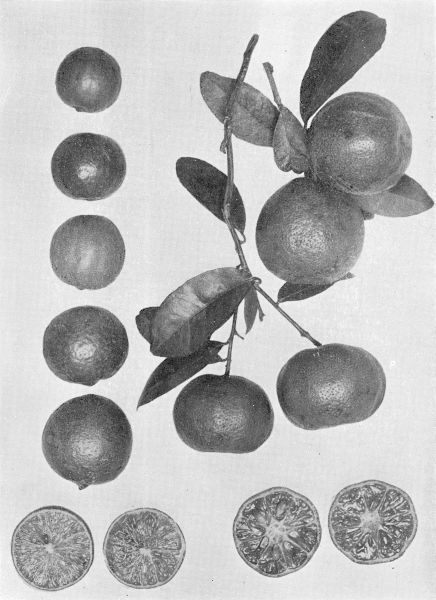
Plate XLI.—Lime.
One half natural size.
One half natural size.
[Pg 88]
Citrus medica limonum.
This is a spreading tree, having ovate-oblong, fragrant leaves with short petioles. The flowers are small and white. The medium-sized fruit is egg-shaped, ending in a nipple-like point. The thin, smooth skin is aromatic. The juicy pulp is rich in citric acid. Many choice varieties of lemons have been introduced to Hawaii, but they have not thrived particularly well, because of the scale and insect pests which so greedily attack them; eternal vigilance is necessary in order to get the fruit matured; some very fine specimens, however, have been grown in Kona, at an elevation of 1500 feet.
[Pg 89]
G. P. W. Collection. Plate XLII
Citrus medica limonum.
LEMON.
This is a spreading tree, having ovate-oblong, fragrant leaves with short petioles. The flowers are small and white. The medium-sized fruit is egg-shaped, ending in a nipple-like point. The thin, smooth skin is aromatic. The juicy pulp is rich in citric acid. Many choice varieties of lemons have been introduced to Hawaii, but they have not thrived particularly well, because of the scale and insect pests which so greedily attack them; eternal vigilance is necessary in order to get the fruit matured; some very fine specimens, however, have been grown in Kona, at an elevation of 1500 feet.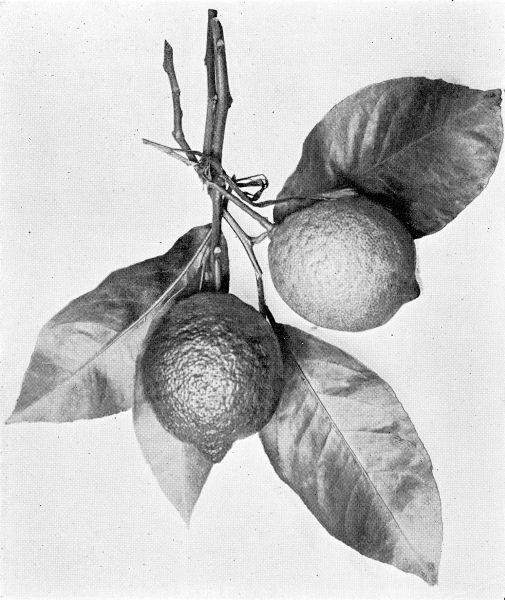
Plate XLII.—Lemon.
One half natural size.
One half natural size.
No comments:
Post a Comment